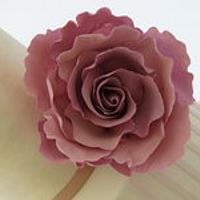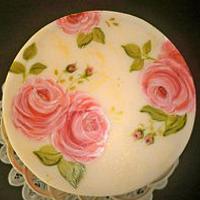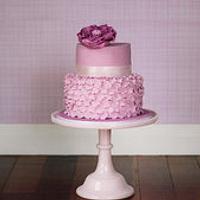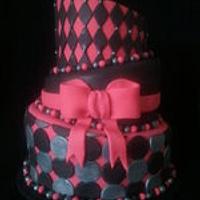Upside Down Ganaching Method for a round cake
Another method for ganaching round cakes based on the Upside Down Buttercream method. This method removes the need for a ganaching “lid” or board the same size as the baseboard – It can be extremely difficult to find two boards exactly the same size and shape, unless you cut them yourself – I’m too bone lazy to do that :)
Cut cake into three even layers, flip the layer which was the top of the baked cake over and attach to a base board (the same size as the tin the cake was baked in) with ganache.
To layer the cake, your ganache needs to be the consistency of peanut butter- if it is too soft it will ooze out between the layers.
Spread ganache over the (now) bottom layer and then add the next (middle) layer of ca…ke. Spread with ganache and then flip the last layer (what was the bottom of the baked cake) over and place on the top of the ganached layer. The bottom of the baked cake becomes the top, flat surface.
Try to make the cake as level as possible to the eye- but don’t go to too much trouble- we’ll fix the levels later :)

Spread some softened white chocolate ganache on a larger “work” board. Attach layered cake (on its base board) to the workboard. Leave to set or put in fridge for a few minutes (no more).
The larger the workboard the better- you will have more room to sit the bottom of the scraper on, which will help prevent the scraper “tipping” up or down.

Trim all around the sides of the cake ensuring a 5mm gap between cake and base board- we will fill this gap with ganache.
The ganache on the sides provides structural stability, and allows you to create a smooth perpendicular side.
To ensure you have trimmed enough cake away, push a metal, square edged scraper up against the edge of the baseboard and run it around the board, trim away any cake that touches the scraper.

To coat the cake, the ganache needs to be softer than it was when we used it to fill the cake. If the ganache is too stiff, it will “pull” pieces of the cake away as you work- so just warm your ganache in the microwave a little before you apply it to the outside of the cake.
Apply ganache thickly to the outside of the cake, ensuring that you bring the ganache slightly above the top edge of the cake.

Use a metal scraper (or straight edge) to remove the excess ganache from the sides of the cake. Place the bottom edge of the scraper against the base board and hold scraper completely perpendicular to the cake side. The bottom edge of the scraper should remain completely in contact with the workboard as you scrape. If the scraper “tips” slightly upward, you will end up with a “flowerpot” shape. If…it tilts forward, your cake will look conical.
To ensure your scraper stays perpendicular, use a turntable and keep the hand with the scraper in it still,whiile turning the turntable with your other hand.
After you have scraped all the way around, check for areas where the scraper has not touched the sides of the cake- these will need to be filled with more ganache and scraped again. See that little bit of board peeking between the edge of the cake and the inside edge of the scraper? This needs to be filled with ganache.
To check that the sides are straight, hold the scraper edge up against the baseboard at several points around the cake- if the scraper leaves a vertical line up and down the outside of the cake, then the sides are straight- if not, add more ganache and scrape again

Fill any gaps around the sides and scrape again- repeat process until the sides are smooth and perfectly straight.
You may need to keep softening the ganache in your bowl as you work. If the ganache on your cake is hard to scrape, heat your scraper in a bowl of hot water and use it to scrape the cake.

Using a spatula tip the top edge of the excess ganache over and smooth in towards middle of the cake.

Add additional ganache to the top of the cake if required and make top of the cake as smooth and level as possible. Chill in fridge for 20 mins to firm up. The cake needs to be firm in order to flip it, otherwise it will fall apart. We cover the top of the cake at this stage just to keep it sealed while it chills.

While cake is chilling, prepare a large square board, covering with florist’s cellophane. Using sticky tape on the paper side of the board, stick sides down, stretching the cellophane tightly. Then use scissors to cut cellophane off at corners.
I use this board instead of another board or ganaching “lid” because 1) it’s impossible to find two boards EXACTLY the same shape and size, and 2) I find boards hard to remove cleanly- cellophane just peels off leaving a mirror smooth surface!


I use a square board so the cellophane can be folded flat behind the board with no bulk to effect the level.

Place board cellophane side up and a level surface.
Soften some ganache slightly in the microwave. It should be pourable but not too runny. Spread a circle of ganache 1 – 2cm thick over the prepared board. The circle should be slightly larger than the cake.

Take the cake out of the fridge and flip over onto the circle of ganache.
If the cake is too large or heavy to flip, wait until the ganache on the board has firmed up a little and flip the board onto the top of the cake, then flip the whole thing over, so the ganache is under the cake.
Working quickly, use a spatula to loosen the seal between the base board and the work board and remove workboard (we will reattach this later). Using a spirit level on the topside of the cake (ie against the bottom of the baseboard) move cake around on softened ganache until the top is perfectly level. Leave cake undisturbed until bottom layer of ganache is firm, but not hard.

Scrape around the outside of the cake once again, use a heated spatula if necessary. Remember this time that there is no board at the bottom, so make sure your scraper doesn’t dig in at the bottom- keep it straight, no tilting or tipping

Scrape and fill sides until they are perfectly smooth and straight. Reattach workboard to top with a little ganache. Turn upside down and place in fridge for ½ an hour. This will firm up the ganache enough to remove the cellophane cleanly.

Remove cake from fridge and use a knife to cut through sticky tape attaching cellophane to board. Remove square board.

Carefully peel back cellophane.

Fill any small gaps caused by air bubbles on top of the cake. Leave to set up at room temperature for 12 hours before covering with fondant.

This tutorial appears in a less dense format at:
https://www.facebook.com/media/set/?set=a.379527582121220.88484.223292057744774&type=3#!/media/set/?set=a.379527582121220.88484.223292057744774&type=3
Eleanor, Brisbane, http://www.facebook.com/#!/Cakeage.Cake.Craft
6 Comments
Oh Eleanor! Thanks so much for sharing this with us! You’re amazing! :) xx
Raewyn, Sydney, Australia https://www.facebook.com/cakesbyraewyn
Thank you for sharing ! Great tutorial!
Love the tutorial!!
Miriam, New Zealand http://www.facebook.com/CreatedandCapturedByMiriam
Hope it is helpful- its just another variation on some great tutes here- we all do things a bit differently to suit our own conditions and purposes :)
Eleanor, Brisbane, http://www.facebook.com/#!/Cakeage.Cake.Craft
Eleanor, you da bomb! Again, wonderful tutorial and so easy to follow x
Kate, Australia - visit me at http://www.facebook.com/thegreedybaker
Great tutorial! Could wax paper be used instead of the floral cellophane? :)
customcakecompany





